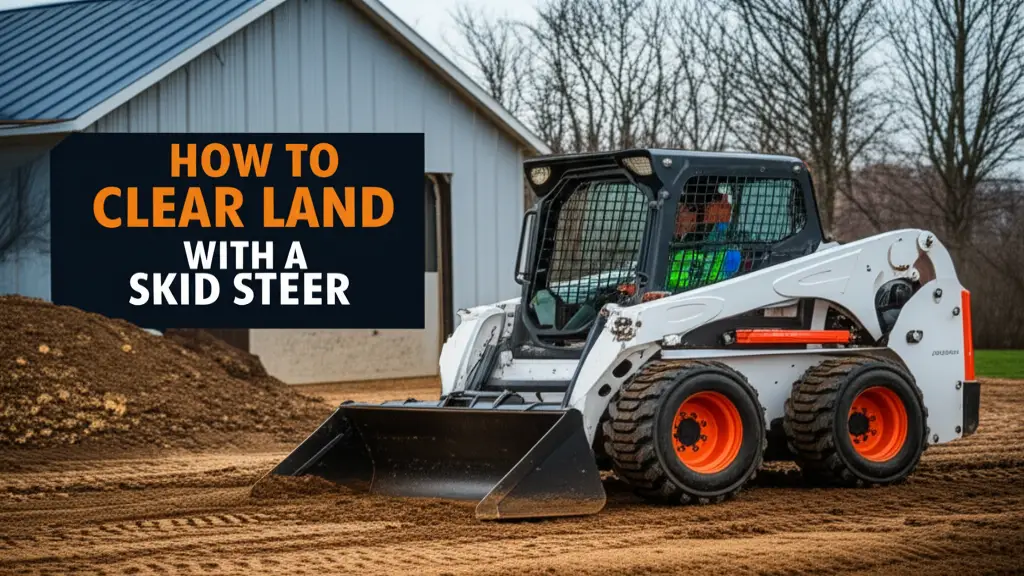· Landscaping & Outdoor · 8 min read
How To Clear Land With A Skid Steer

Clearing Land the Smart Way: A Guide to Using a Skid Steer
Have you got a plot of land overrun with vegetation and ready for a fresh start? Clearing land can feel like a daunting task, but with the right equipment and techniques, it can be surprisingly manageable. A skid steer is a powerful and versatile machine perfectly suited for this job. This article will walk you through everything you need to know about how to clear land with a skid steer, from choosing the right attachments to prioritizing safety. We’ll cover the entire process, ensuring you can tackle even the toughest terrain.
Takeaway:
- Choose the right skid steer attachments for the type of vegetation you’re clearing.
- Prioritize safety by wearing appropriate PPE and understanding your machine’s capabilities.
- Plan your clearing strategy to maximize efficiency and minimize environmental impact.
- Regularly inspect your skid steer and attachments for maintenance needs.
Quick Answer:
To clear land with a skid steer, select the appropriate attachment (brush hog, forestry cutter, grapple), prioritize safety with PPE, and systematically remove vegetation, starting with smaller brush and moving to larger trees. Proper planning and maintenance are key to efficient and safe land clearing.
1. Understanding Your Skid Steer and Its Capabilities
Before you begin, it’s important to understand what your skid steer can handle. Skid steers are known for their maneuverability and lifting capacity, but they aren’t invincible. Different models have different rated operating capacities, so check your machine’s manual. Knowing this limit will prevent overloading and potential damage. Consider the horsepower of your skid steer, as this directly impacts the size and type of attachments it can effectively run. A more powerful machine will handle heavier brush and larger trees with greater ease.
2. Essential Skid Steer Attachments for Land Clearing
The right attachment is crucial for efficient land clearing. Here are some of the most common and effective options:
- Brush Hog (Rotary Cutter): Ideal for mowing down thick brush, weeds, and small saplings. These are great for initial clearing and maintaining open areas.
- Forestry Cutter (Mulcher): Designed for tackling trees and heavier brush. They grind the vegetation into mulch, which can be left on-site to enrich the soil.
- Grapple: Perfect for grabbing and moving logs, rocks, and debris. Grapples come in various sizes and styles, including root grapples for pulling out stumps.
- Dozer Blade: Useful for pushing over smaller trees and leveling the ground after clearing.
- Tree Puller: Specifically designed to uproot small to medium-sized trees, making stump removal easier.
- Pallet Forks: While not directly for clearing, they are useful for moving materials around the job site.
Choosing the right attachment depends on the type of vegetation you’re dealing with. For example, if you have a lot of small trees, a forestry cutter is a good choice. If you’re dealing with mostly brush, a brush hog will be more efficient. If you need to move a lot of debris, a grapple is essential. Don’t forget to check the compatibility of the attachment with your skid steer’s hydraulic system.
3. Prioritizing Safety During Land Clearing
Safety should always be your top priority when operating heavy machinery. Here’s a checklist to ensure a safe working environment:
- Personal Protective Equipment (PPE): Always wear a hard hat, safety glasses, hearing protection, gloves, and sturdy work boots. Long sleeves and pants are also recommended.
- Machine Inspection: Before each use, inspect your skid steer and attachment for any damage or wear. Check fluid levels, tire pressure, and hydraulic hoses.
- Clear the Area: Remove any obstacles from the work area, such as rocks, fences, or debris.
- Awareness of Surroundings: Be aware of your surroundings and potential hazards, such as overhead power lines or hidden obstacles.
- Roll-Over Protection: Ensure your skid steer has a functioning ROPS (Roll-Over Protective Structure) and that you are always wearing your seatbelt.
- Read the Manual: Familiarize yourself with the skid steer’s operating manual and the attachment’s instructions.
Understanding your machine’s limitations and following safety procedures will significantly reduce the risk of accidents. If you’re unsure about any aspect of operation, consult a qualified mechanic or operator. Consider taking a safety course specifically for skid steer operation.
4. Developing a Land Clearing Strategy
A well-thought-out strategy will save you time and effort. Start by walking the land and assessing the vegetation. Identify the largest trees and plan how you will remove them. Begin by clearing smaller brush and weeds with a brush hog or forestry cutter. This will give you better visibility and access to larger obstacles.
Next, tackle the trees. Use a forestry cutter to grind them down, or a grapple to pull them over. If you’re pulling trees, be mindful of the direction they will fall. Once the trees are down, use a grapple to move them to a designated staging area. Finally, use a dozer blade to level the ground and remove any remaining debris. Consider the environmental impact of your clearing activities. Avoid disturbing sensitive areas and minimize soil erosion. You might want to consult local regulations regarding land clearing permits.
5. Maintaining Your Skid Steer and Attachments
Regular maintenance is essential for keeping your skid steer and attachments in good working order. After each use, clean the machine and attachments to remove dirt, debris, and vegetation. Inspect hydraulic hoses for leaks and damage. Lubricate all moving parts according to the manufacturer’s recommendations.
Check the fluid levels regularly and top them off as needed. Sharpen or replace cutting blades on your brush hog or forestry cutter to maintain optimal performance. Store your skid steer and attachments in a dry, sheltered location to protect them from the elements. Following a regular maintenance schedule will extend the life of your equipment and prevent costly repairs. If you notice any unusual noises or performance issues, have your skid steer inspected by a qualified mechanic. You can find more information on general equipment maintenance at https://www.beacleaner.com/azeus-air-purifier-cleaning-and-maintenance.
6. Dealing with Specific Challenges: Stumps and Rocks
Land clearing often presents unexpected challenges. Stumps can be particularly difficult to remove. A tree puller attachment can help, but for larger stumps, you may need to use a stump grinder or excavate them. Rocks can also pose a problem. Use a grapple to move smaller rocks, but larger rocks may require a rock bucket or excavator. Be careful when working around rocks, as they can damage your skid steer’s tires and undercarriage. Always wear appropriate PPE when dealing with stumps and rocks. Consider the soil type when removing stumps, as sandy soil will be easier to work with than clay soil.
7. Final Touches and Site Cleanup
Once you’ve cleared the land, it’s time for the final touches. Level the ground with a dozer blade or grader. Remove any remaining debris and dispose of it properly. Consider seeding or planting vegetation to prevent erosion and restore the land. Inspect the area for any hazards and address them accordingly. A clean and well-maintained site will be ready for your next project. Proper site cleanup is crucial for creating a safe and functional space. You can find helpful tips on cleaning up after outdoor projects at https://www.beacleaner.com/how-to-remove-baking-soda-residue-from-carpet/.
Frequently Asked Questions (FAQ)
Q: What’s the best attachment for clearing dense brush? A: A brush hog (rotary cutter) is generally the most efficient attachment for clearing dense brush and weeds. It quickly cuts down vegetation, making it easier to manage.
Q: Is a forestry cutter safe to use near fences? A: Forestry cutters can throw debris, so maintain a safe distance from fences and other structures. Always wear appropriate PPE and be aware of your surroundings.
Q: How do I prevent damage to my skid steer tires? A: Avoid driving over sharp rocks or debris. Maintain proper tire pressure and inspect your tires regularly for cuts or punctures.
Q: What should I do with the cleared vegetation? A: You can chip the vegetation into mulch, burn it (if permitted by local regulations), or haul it away for disposal.
Q: Can I clear land on a steep slope with a skid steer? A: Clearing land on a steep slope can be dangerous. Use extreme caution and consider using a different type of equipment, such as an excavator.
Q: How often should I inspect my skid steer’s hydraulic system? A: Inspect your hydraulic system before each use for leaks, damage, and proper fluid levels.
Conclusion
Clearing land with a skid steer is a powerful and efficient way to prepare a site for construction, landscaping, or other projects. By choosing the right attachments, prioritizing safety, and developing a strategic approach, you can tackle even the most challenging terrain. Remember to regularly maintain your skid steer and attachments to ensure optimal performance and longevity. With a little planning and effort, you can transform overgrown land into a beautiful and functional space. So, get out there, put these tips into practice, and enjoy the satisfaction of a job well done!
- skid steer
- land clearing
- brush hog
- forestry cutter
- skid steer attachments




